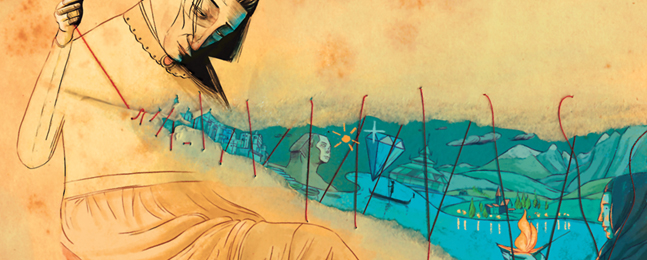One Hundred Years of Solitude
A century after her death, an obscure American Jewish writer may finally get the recognition she deserves.

Courtesy the Jacob Rader Marcus Center of the American Jewish Archives
SOWING STORIES: Wilburn drew upon her own life in her serialized novel “Cosella Wayne.”
by Lawrence Goodman
Cora Wilburn was one of the most prolific American Jewish writers of the 19th century. She wrote poetry, essays and fiction that grappled with big issues like assimilation, poverty, child abuse and feminism. A fellow writer described her as “the most interesting woman I know.” But by the 1920s, she’d been completely forgotten.
Last October, Wilburn finally got her due. The University of Alabama Press published her 1860 novel “Cosella Wayne,” edited and with an introduction by University Professor Jonathan Sarna ’75, MA’75, the Joseph H. and Belle R. Braun Professor of American Jewish History.
When Sarna discovered the novel while researching Wilburn’s life, he realized he had found the first American Jewish literary novel. The book, he says, “transforms what we know about the history of early American Jewish literature and adds an important new name to the pantheon of 19th-century Jewish women writers.”
At Cincinnati’s Jacob Rader Marcus Center of the American Jewish Archives, Sarna also tracked down Wilburn’s diary, which reveals she drew upon her own life for “Cosella Wayne,” making the novel the first example of an American Jewish writer using an alter ego in her fiction. To highlight the parallels between real life and fiction, Sarna included diary excerpts in his edition of “Cosella Wayne.”
Wilburn was born Henrietta Pulfermacher in Alsace, in eastern France, in 1824. She lost her mother at an early age and was raised by her father, a crooked gem merchant who hauled his family around the world in search of foreigners to swindle (in one scheme, he impersonated Sir Moses Montefiore, a British financier, philanthropist and sheriff of London). Wilburn loathed her father, who likely abused her, and was probably only too glad to abandon her birth name once she got to America.
Her writing career was born of the poverty her father’s death plunged her into in 1845. After a few years of working as a seamstress, she made a living by writing poems, essays and fiction for journals and magazines.
A committed abolitionist and feminist, Wilburn recognized the constraints she faced because of her gender. “Were I not bound by woman’s fate, that keeps / Me here inactive, while man grandly reaps, / I would, in Israel’s sweet and holy name, / Help to enkindle the world’s freedom-flame,” she proclaims in a poem.
In the 1850s, Wilburn joined the Spiritualist movement, which held that the deceased communicate with the living from a spirit world. Many of her writings — including “Cosella Wayne,” in serial form — were published in Spiritualist journals. Though some Spiritualists championed free love, Wilburn advocated sexual purity. The movement attracted her because of its opposition to slavery and its ties to the women’s movement. “Let woman be free; and she will be what God ordained and Nature desired, a beautiful loving being, full of holy sympathies and boundless aspirations,” she wrote in one essay.
Wilburn, who briefly converted to Catholicism after her father’s death, was anguished by her turn away from Judaism. “A lot of guilt comes out in the diary,” Sarna says. “She feels God has punished her, and she deserved it.” Wilburn returned to Judaism upon her arrival in the U.S. in 1848 and 21 years later rejected Spiritualism, remaining a Reform Jew until her death.
“Cosella Wayne” tells the story of its eponymous hero, who — after her mother dies in childbirth — is abducted, terrorized and physically abused by an evil, alcoholic gem merchant named Menasseh Moshem. Eventually, Cosella escapes to the home of a Catholic neighbor, though she finds no refuge in Catholicism. After her adopted mother turns out to be an adulteress, Cosella undergoes a religious crisis.
Moshem’s death leaves Cosella penniless, and she’s forced to work as a seamstress for pittance wages. On the verge of death, Cosella is rescued by members of the Spiritualist movement and reunited with her true father, a Spiritualist leader, who had spent years searching for her.
Though the novel is no literary masterpiece, Sarna says it provides invaluable accounts, based on Wilburn’s own travels, of Jewish communities and ceremonies around the world about which historians today know very little.
For instance, Cosella travels to India for Passover. Her host’s outfit, Wilburn writes, is “Turkish in form, and was composed of rainbow hued silk and ruby colored velvet, richly embroidered with gold. The snowy muslin folds that veiled her bosom were inwrought with precious gems; three bracelets, richly studded with diamonds and rubies, glistened from each fair, round arm, as the velvet sleeve flew back.”
In Germany, at Yom Kippur services, Cosella beholds male congregants “clad in the habiliments of the grave, the sweeping shroud of linen, with its wide cape edged with lace, the conical cap upon their heads.” Women sit in a gallery above, wearing “dresses of pure white, emblematic of the forgiveness of sins. [...] Some retain their glittering jewels, their pearls and rings; but the truly pious divest themselves of all outward adornment, and stand in true humility before the Lord.”
By the 1870s, Wilburn’s writing had fallen out of fashion. Her “woman’s fate” meant living alone in Duxbury, Massachusetts, plagued by infirmities and dependent on handouts from Boston’s Jewish community. When she died in 1906, she was, as she described it, “homeless, almost friendless, sick, uncared for as I deserve to be.”
Sarna hopes the publication of “Cosella Wayne” restores Wilburn to her rightful place in the pantheon of American Jewish writers. “It’s an amazing novel, full of amazing stuff,” he says. “And it’s so Jewish.”
